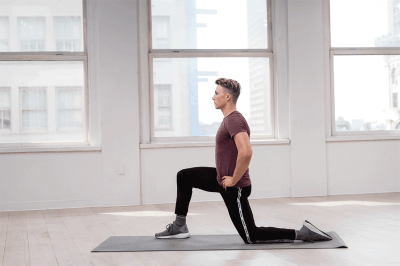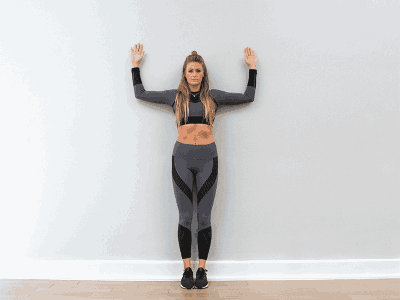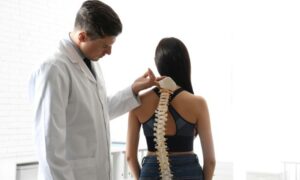For many, the undulating curve of a scoliosis-afflicted spine remains a hidden discomfort, an internal battle against not just back pain but the radiating repercussions it sends throughout the body. One such repercussion that often goes unnoticed until it becomes a chronic companion is hip pain. If you’ve ever found yourself asking, “Could my hip pain be connected to my scoliosis?” you’re not alone. This guide aims to unravel the intricate ties between scoliosis and hip pain, offering insights, remedies, and a beacon of hope to those in search of relief.
Contents
Defining Scoliosis: A Quick Overview
 At its core, scoliosis is a sideways curvature of the spine that can vary in severity from a minor bend to a pronounced arc. Unlike the natural curves of the spine in the neck, upper back, and lower back, scoliosis curves can develop as an “S” or a “C” shape, often giving the spine an asymmetrical appearance.
At its core, scoliosis is a sideways curvature of the spine that can vary in severity from a minor bend to a pronounced arc. Unlike the natural curves of the spine in the neck, upper back, and lower back, scoliosis curves can develop as an “S” or a “C” shape, often giving the spine an asymmetrical appearance.
Most cases of scoliosis are termed “idiopathic,” meaning the cause is unknown. However, some arise due to conditions like cerebral palsy or muscular dystrophy. While it can appear at any age, it’s most commonly detected during the growth spurt just before puberty.
The implications of scoliosis aren’t just cosmetic. A pronounced curve can reduce the amount of space within the chest, making it harder for the lungs to function properly. Moreover, as we will delve into, its ramifications can radiate beyond the spine, often influencing areas like the hips.
How Scoliosis Affects Hip Alignment and Function
When we think of scoliosis, our immediate visualization tends to revolve around the spine. But the interconnected nature of our skeletal system means that a distortion in one area can have a ripple effect across the body. One of the most significant areas affected by spinal curvature is the hips. Here’s how:
- Altered Pelvic Position: When the spine curves due to scoliosis, the pelvis may tilt or rotate to compensate, leading to hip misalignment. This uneven weight distribution can result in one hip being higher than the other, contributing to imbalances and discomfort.
- Muscular Imbalances: With the pelvis tilted, the muscles around the hip joint can experience uneven stresses. Muscles on one side might become tight and overactive, while those on the opposite side can become weakened. This imbalance not only causes pain but also affects the function and range of motion of the hip joint.
- Increased Wear and Tear: A misaligned hip joint often experiences uneven wear and tear. Over time, this can accelerate degenerative changes in the hip, like osteoarthritis, causing pain and stiffness.
- Gait Disturbances: The way we walk, or our ‘gait’, can be affected by scoliosis-induced hip misalignment. This can lead to an uneven stride, further exacerbating hip pain and even leading to issues in the knees, ankles, and feet.
- Compensatory Changes: To cope with the pain or discomfort caused by the hip misalignment, individuals might unconsciously adjust their posture or movements. These compensatory changes can lead to further musculoskeletal problems, both in the hip region and elsewhere in the body.
Understanding the profound influence of scoliosis on hip function underscores the importance of holistic treatment approaches. Addressing the spine alone might not alleviate all associated discomforts; a comprehensive approach considering the hips and other affected areas is essential.
Symptoms Signifying Scoliosis-Related Hip Pain

Scoliosis doesn’t just cause visible spinal curvature; it can manifest through various symptoms, especially in the hip region. Recognizing these signs early can guide appropriate intervention. Here are some tell-tale symptoms of scoliosis-related hip pain:
- Uneven Hips: One of the most evident signs is when one hip appears higher or more protruded than the other.
- Pain on One Side: Pain that’s concentrated on one side of the hip can indicate an imbalance due to spinal curvature.
- Limited Range of Motion: You might find it challenging to move the hip joint through its full range, especially on the side affected by the scoliosis.
- Limping: A change in your gait, particularly favoring one leg over the other or limping, can be a sign of scoliosis affecting hip function.
- Muscle Tightness or Spasms: Muscles around the affected hip may become tight or go into spasms, causing sudden, sharp pain or a dull, constant ache.
- Uneven Leg Lengths: In some cases, the misalignment of the hips can make one leg appear shorter than the other, leading to an uneven distribution of weight and consequent pain.
- Radiating Pain: In certain instances, the pain may not be localized only to the hip. It might radiate down the thigh or even up towards the lower back.
If you notice any combination of these symptoms, it’s crucial to consult with a healthcare professional. They can help discern if your hip pain is indeed linked to scoliosis and guide you towards the best management and treatment strategies.
Exercises and Posture Adjustments for Relief
The journey towards reducing scoliosis-induced hip pain begins with strengthening the surrounding muscles and ensuring proper posture. Here are some exercises and posture adjustments that can make a significant difference:
Pelvic Tilts

This exercise can help in strengthening the lower back and pelvic muscles.
- Lie on your back with your knees bent and feet flat on the floor.
- Tighten your abdominal muscles, pushing your lower back into the floor.
- Hold for a few seconds and then relax.
- Repeat for 10-15 times.
Child’s Pose Stretch

Ideal for stretching the back and relieving tension around the hips.
- Start by sitting on your heels with knees together.
- Lean forward, extending your arms in front and lowering your chest towards your thighs.
- Hold for 20-30 seconds, feeling the stretch in your back and hips.
Hip Flexor Stretch

Directly targets the hip muscles and can provide relief from tightness.
- Begin in a lunge position with one foot forward and the other extended behind.
- Push your hips forward gently until you feel a stretch in the front of your hip.
- Hold for 20-30 seconds and then switch sides.
Spinal Rotation

Good for improving spinal mobility and reducing stiffness.
- Lie on your back with your arms extended outwards and knees bent.
- Gently drop your knees to one side while turning your head to the opposite side.
- Hold for a few seconds, then return to the center and repeat on the other side.
Wall Angels

Helps in improving posture and shoulder mobility.
- Stand with your back against a wall, with arms extended outwards.
- Slowly slide your arms up, keeping them in contact with the wall.
- Slide them back down and repeat.
Standing Tall
Posture plays a crucial role in managing hip pain stemming from scoliosis.
- Ensure that weight is distributed evenly on both feet.
- Keep shoulders back and relaxed, with the chest out and chin up.
- Check your posture periodically, especially if standing for long periods.
Seated Posture Adjustments
- Sit all the way back in your chair.
- Keep feet flat on the floor, and knees at a right angle.
- Use a lumbar roll or cushion to support the natural curve of your lower back.
Consistency is the key. Regularly performing these exercises and being mindful of your posture can pave the way for better hip and spine health, reducing the discomfort associated with scoliosis.
When to Consult a Professional
While exercises and posture adjustments can offer relief from scoliosis-related hip pain, it’s vital to understand when professional intervention becomes necessary.
- If the pain in the hip or back persists for more than a few weeks, even with home remedies and exercises, it’s time to see a professional.
- Any increase in the severity of pain, especially if it begins to interfere with daily activities, indicates the need for expert attention.
- A visible increase in the curvature of the spine or any asymmetry in the body posture should be a cause for concern.
- If pain intensifies after performing the recommended exercises, it could indicate that the movements aren’t suitable or are being done incorrectly.
Once any of these signs are noticed, it’s prudent to seek out a healthcare professional, ideally one who specializes in musculoskeletal disorders or spinal conditions.
Therapeutic Approaches to Manage Hip Pain from Scoliosis
 Professional therapeutic approaches can address the root cause of the issue and offer long-term relief. Here are some common therapeutic strategies:
Professional therapeutic approaches can address the root cause of the issue and offer long-term relief. Here are some common therapeutic strategies:
- Physical Therapy: Tailored exercise regimens and manual therapy techniques can help improve posture, strengthen muscles, and alleviate pain. A trained physical therapist can guide patients through specific exercises that target the problematic areas.
- Chiropractic Care: Chiropractic adjustments can help realign the spine and improve its function, which can reduce the strain on the hips.
- Bracing: In some cases, especially for adolescents with growing spines, a brace can help prevent further curvature and alleviate associated symptoms.
- Pain Management Techniques: These can include hot/cold therapy, ultrasound, electrical stimulation, and more, which can be utilized to reduce inflammation and pain.
- Surgery: In severe cases, when other treatments don’t offer relief, spinal surgery might be recommended to correct the curvature and relieve pressure on the hips.
- Medications: Over-the-counter pain relievers or prescribed medications can help manage pain and inflammation.
Combining these therapeutic approaches with the knowledge and expertise of a professional can make a significant difference in managing hip pain caused by scoliosis.
Conclusion
Scoliosis and its link to hip pain is a complex interplay that can significantly affect one’s quality of life. Understanding the nuances of this relationship and adopting effective strategies can pave the way for a pain-free and active lifestyle. Remember, enduring the pain is not the solution. Early intervention and expert guidance are paramount. If you’re experiencing Hip pain, physical therapy for hip pain at PhysioMantra can help: Book an online physical therapy session.



